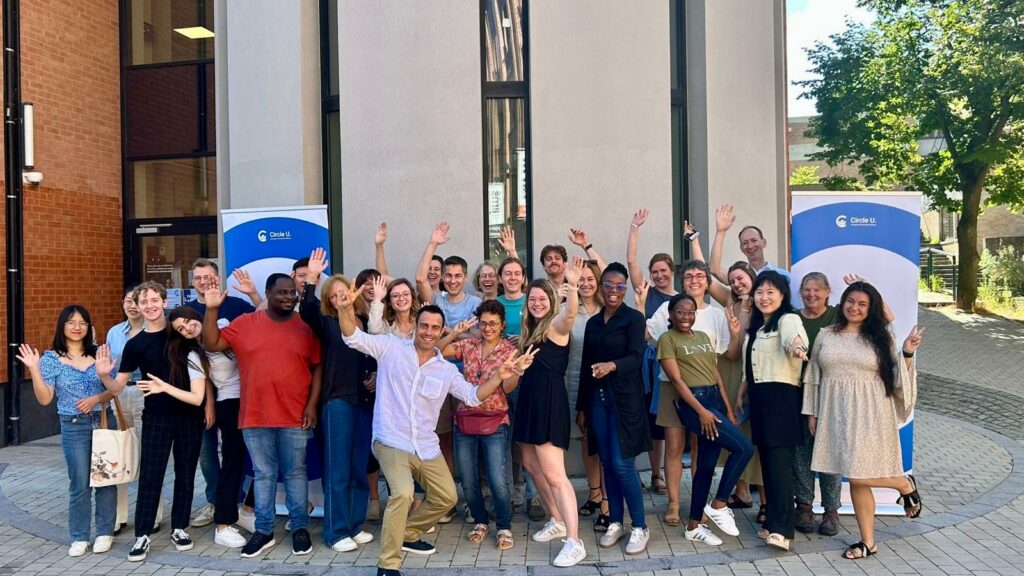Project Title: Learning Impact of Translanguaging in Multilingual Content-Based Instruction Classrooms
Funder: National Research Foundation (NRF) South Africa/Flanders Collaboration projects (2024-2026)
Research Project Abstract
Given Western society’s demographic hybridity and multiculturalism, monolingual classroom interaction is becoming increasingly rare (e.g. Agirdag, 2014; Vertovec, 2006). Learners from different linguistic backgrounds are part of the same target group, which should be addressed by adopting optimal methods that correspond to and fulfil the needs of multilingual classrooms. For multilingual language practices in such contexts as second and foreign language learning and (youth) conversational interaction, the generic term ‘translanguaging’ (TL) has come into use in multilingual education and research.
With the rapid expansion of CBI (Content-Based Instruction), CLIL (Content and Language Integrated Learning, i.e. taking a subject in a foreign language) and EMI education (English Medium Instruction) in many countries worldwide, multilingualism is entering language education with a great heterogeneity of idiosyncratic TL practices (Jaspers, 2019). This proliferation makes critical empirical research into TL necessary and urgent, especially since recent studies indicate that teachers lack confidence in how to deal with the role of language (e.g. Bulté, Martens, & Surmont, 2020). This is corroborated by our pilot study in Flemish schools offering English CLIL as part of CBI (Du. talenbeleid), that yields crucial multilingualism research data. Facilitating learning in CLIL or EMI programmes does indeed imply ”integrat[ing] not only language and content but also all the languages in the learners’ multilingual repertoires” (Cenoz, 2013, p. 393). Considering the impact of teachers and their classroom practice on learning outcomes, evidence-based improvements of CBI/CLIL/EMI teachers’ support and stimulation of (language) learning may leverage this impact exponentially. Moreover, the aforementioned as well as other studies illustrate that currently implemented practices are not sufficient to stimulate (language) learning: as the latest PISA results show, since 2000 e.g. Flemish learners’ reading comprehension and motivation are in steady decline (OECD, 2019). In the latest report, almost 20% of these learners are considered low achievers. PIRLS results over the last fifteen years show a decline in most countries, including Flanders (Belgium), in fourth graders’ reading attitudes (Dockx et al., 2019; Hooper, 2020). Interest in language competences is facing growing importance in knowledge societies but also greater risk, as the pandemic health crisis is reinforcing trends from nationalism to deglobalization. The multicultural and multilingual composition of classrooms in Belgium and beyond therefore provides an extra challenge to motivate learners into language learning (Smits & Janssenswillen, 2020).
Recently, the generalizability of much research in the field of SLA (Second Language Acquisition) has been questioned given the reliance on WEIRD samples (Western, Educated, Industrialized, Rich, and Democratic) (Andringa & Godfroid, 2020) and the lack of replication studies (REFs). Indeed, most SLA studies have recruited university learners as participants and few examples exist of research problems affecting the global North that find their solution in experience and expertise in the global South. Given the long history of research into language alternation in South African multilingual classrooms, they provide a resourceful research context (see also Ortega’s (2008) and Pfenninger & Singleton’s (2019) plea to avoid a monolingual bias in SLA research). Moreover, given the ”need to move beyond merely describing language practices in classrooms to examining how these impact on learning” (Probyn, 2019, p. 217; Ferguson, 2009), an experimental approach to TL effectiveness research in a multilingual context is called for. Hence, the proposed project will constitute pioneering fundamental research, as the intersection of TL and second/foreign language pedagogy discloses how multilinguals communicate in the institutionalised setting of language education (CBI/CLIL/EMI) and what effective TL pedagogy should consist of.
With its innovative micro-analytic approach (CA-for-SLA) to uncover epistemic and pedagogical phenomena, the project provides evidence-based knowledge essential for fundamental linguistic and educational research on multilingual practices in CBI (CLIL/EMI). Beyond the descriptive aspect of the research, a quasi-experimental design with translanguaging as independent variable and classroom interaction and learner motivation as dependent variables indicative of learner engagement will be deployed. Learner engagement is measured in terms of behavioural and cognitive components: behavioural engagement in terms of (multilingual) semantic content produced by learners (i.e. number of words produced in pruned discourse indicative of the amount of time invested in oral interaction); cognitive engagement in terms of attention to elaborating and clarifying content (i.e. number of clauses expanding on the semantic content of the narrative, e.g. suggestions, propositions, elaborations, rea-sons, and opinions, and number of turns negotiating the content, e.g. corrective feed-back, modified output, co-constructions, confirmation checks, clarification requests and metalinguistic changes). Engagement as defined in the recent SLA literature (Philp & Duchesne, 2016) refers to a state of heightened attention and involvement, in which participation is reflected not only in the purely behavioural dimension, but also in manifestations of cognitive and social engagement, and in the affective dimension of learner’s subjective feelings and responses to the aforementioned behavioural and cognitive components of the teaching and learning environment. To conclude, the study’s scientific output yields validation opportunities for an audience of SLA re-searchers, teachers (educators), syllabus designers and policy makers.
The project aims to achieve the following:
- Plurilingual perspective on foreign/second language (mediated) education
- Translanguaging interpretative framework analysed with innovative CA-for-SLA .
- North-South fundamental research partnership with mutual relevance.
The project is innovative at three levels:
- Quasi-experimental translanguaging research in multilingual classrooms.
- Addressing the knowledge gap in research on translanguaging strategies across the high school curriculum.
- Examining students and teachers (co-creational) use of a multilingual repertoire in the institutionalized setting of high school Business and Science classrooms from a hermeneutics perspective.
Reference List
Agirdag, O. (2014). The long-term effects of bilingualism on children of immigration: student bilingualism and future earnings. International Journal of Bilingual Education and Bilingualism, 17(4), 449-464.
Andringa, S., & Godfroid, A. (2020). Sampling bias and the problem of generalizability in applied linguistics. Annual Review of Applied Linguistics, 40, 134-142.
Bulté, B., Martens, L., & Surmont, J. (2020). CLIL in Vlaanderen. Praktijkgericht Wetenschappelijk Onderzoek. Retrieved from: https://www.ucll.be/sites/default/files/documents/lerarenopleiding/eindrapport_pwo_clil.pdf.
Cenoz, J. (2015). Content-based instruction and content and language integrated learning: The same or different? Language, culture and curriculum, 28(1), 8-24.
Dockx, J., Van Landeghem, G., Aesaert, K., Van Damme, J., & De Fraine, B. (2019). Begrijpend lezen van het vierde naar het zesde leerjaar: Herhalingsmeting van PIRLS in 2018 vergeleken met PIRLS 2016. Centrum voor Onderwijseffectiviteit en -evaluatie. Leuven: KULeuven. Retrieved from: https://www.onderwijs.vlaanderen.be/en/node/5317
Ferguson, G. 2009. “What next? Towards an Agenda for Classroom Codeswitching Research.” International Journal of Bilingual Education and Bilingualism, 12 (2): 231-241.
Hooper, M. (2020). Troubling trends: An international decline in attitudes toward reading. International Association for the Evaluation of Educational Achievement (IEA). Retrieved from: https://www.iea.nl/publications/series-journals/iea-compass-briefs-education-series/march-2020-troubling-trends
Jaspers, J. (2019). Authority and morality in advocating heteroglossia. Language, Culture and Society, 1(1), 83-105.
Ortega, M. (2008). Cross-linguistic influence in multilingual language acquisition: The role of L1 and non-native languages in English and Catalan oral production. Íkala, revista de lenguaje y cultura, 13(19), 121-142.
Pfenninger, S. E., & Singleton, D. (2019). Making the most of an early start to L2 instruction. Language Teaching for Young Learners, 1(2), 111–138.
Probyn, M. (2015). Pedagogical translanguaging: Bridging discourses in South African science classrooms. Language and Education, 29(3), 218-234.
Smits, T. F., & Janssenswillen, P. (2020). Multicultural teacher education: a cross-case exploration of pre-service language teachers’ approach to ethnic diversity. International Journal of Qualitative Studies in Education, 33(4), 421-445.
Vertovec, S. (2006). The emergence of super-diversity in Britain. COMPAS Working Papers, 25. Retrieved from: https://www.compas.ox.ac.uk/2006/wp-2006-025-vertovec_super-diversity_britain/
Principal Investigators
Professor (Dr ) Nhlanhla Mpofu, Stellenbosch University, South Africa

Professor (Dr) Tom Smits, University of Antwerp, Belgium

Postdoctoral Fellow in the project
PhD students in the Project
Adolph Sekgobela. Content-Based Instruction Pedagogies used in teaching English subject in South Africa and Flanders: A mix method study.
Abstract
This study aims to investigate the use of Content-Based Instruction (CBI) pedagogies in the teaching of the English subject in secondary schools in South Africa and Flanders, Belgium. CBI is an approach where language learning is integrated with the learning of academic content, to develop both language proficiency and subject knowledge simultaneously. The study will use a mixed-methods research design, incorporating quantitative and qualitative data collection and analysis. Quantitative data will be gathered through surveys of English teachers in the two regions to understand the extent of CBI implementation, teachers’ perceptions, and challenges encountered. Qualitative data will be obtained through classroom observations and interviews with teachers to gain deeper insights into CBI practices, instructional strategies, and integration of language and content. By comparing the use of CBI pedagogies in the two contexts, the study seeks to identify common challenges, practices, and contextual factors that influence the adoption and effectiveness of CBI approaches in secondary English education. The findings will provide valuable insights to inform teacher training, curriculum development, and policy decisions related to language-driven content instruction in multilingual school settings.
Marta Ndakalako Alumbungu. Differentiated approaches to reading instruction in multilingual and superdiverse Namibian and Flemish primary school: a mixed method study.
Abstract
This mixed-methods study proposes to investigate how teachers in multilingual, superdiverse primary school classrooms in Namibia and Flanders, Belgium adapt their reading instruction to meet the diverse needs of their students. Drawing on theories of differentiated instruction and language-sensitive pedagogy, the study will examine the instructional strategies, materials, and grouping practices teachers use to support students’ reading development. Qualitative classroom observations and teacher interviews will provide in-depth insights into teachers’ decision-making and implementation of differentiated approaches. Quantitative student reading assessments will measure the impact of these instructional adaptations on student outcomes. The study aims to contribute to the limited research on reading instruction in multilingual African and European school contexts. The findings will offer practical guidance for teachers, school leaders, and policymakers on effective practices for supporting the reading development of linguistically diverse student populations. Results will inform the design of teacher professional development programs, curriculum materials, and educational policies to better serve the needs of students in superdiverse school environments. Overall, this comparative, cross-national study will enhance the understanding of differentiated reading instruction to promote equity and achievement for multilingual learners.
Tsitsi Mavambe. Pedagogical strategies for teachers to enhance reading among multilingual non-readers in primary schools: a quasi-experimental study.
Abstract
Despite the importance of early reading skills for academic success, many multilingual students continue to struggle with reading, falling behind their peers. This quasi-experimental study will compare the reading outcomes of students whose teachers receive specialised training in evidence-based instructional methods for multilingual learners, versus a control group of students whose teachers use standard teaching practices. The study will be conducted over one academic year in ten primary schools serving diverse, low-income communities. Researchers will assess students’ reading abilities at the beginning and end of the year using standardized assessments. Teachers in the intervention group will receive professional development on strategies such as sheltered instruction, vocabulary building, and structured phonics lessons tailored to multilingual learners. Student attendance, engagement, and perceptions will also be measured to provide a holistic evaluation of the intervention. It is hypothesized that students whose teachers implement the specialized pedagogical strategies will demonstrate significantly greater gains in reading proficiency compared to the control group. The findings could inform policy and teacher training programs to better support the literacy development of multilingual students in primary education. The study’s quasi-experimental design and mixed-methods approach aim to yield robust, actionable insights for educational practitioners and researchers.
Project in pictures




